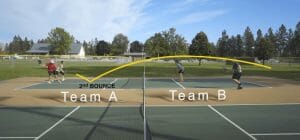The double bounce rule in pickleball is one of the trickiest and confusing regulations for the newbies. Anyone who just started to put feet on the court will be super distracted with this double bounce and other complex rules.
The game may look simple, but the rules are not.
Rules may sound boring, but they have some significant significances. Firstly, they make the game fair for everyone, and secondly, you won’t feel the excitement unless there is any challenge involved.
We have gathered all the nooks and coons about the double bounce rule here to quadruple your pickleball fun.
Official Rules for Double Bounce
In a nutshell, the double bounce rule says: after the service has taken place, each team must let the ball drop once in the court surface before hitting.
Are you still a bit confused? Let’s explain it another way. Both the teams have to play their first shot of a bounce at each point of the game. That means when a team serves the ball towards the opposing team, the receiving team must strike the ball after the first drop in the receiving court.
This one bounce will not apply anymore after the first shot of both teams has been taken after a service. Both teams can play dropped or volley shots; however, they can play it, as long as the ball remains in the court area.
Therefore, the double bounce rule in pickleball is only applicable for the first shots of both teams, after a service.


Serve & Return
The double bounce rule is associated with the services. So players, especially newbies, must have knowledge about the law. Pickleball serves primarily of 3 types: Soft serve, High serve, and Power serve. In pickleball, you must service using an underarm shot.
Moreover, the underarm serving shot needs to be diagonal. So, the ball must travel diagonally across the non-volley zone. You need to keep in mind that the ball must cross the centerline or net and bounce beyond the 7 feet line of the receiving team’s court. A service will only be counted legal after the ball has crossed both the net and the opposing team’s volley zone.
Now let’s say you are on the receiving team. So, as the ball coming toward you, you have to let it bounce at least once in the court, and only after that, you are allowed to return shot.
Just a reminder again that once your and the opponent’s team have done their first shot after a single bounce on each side, you are all free to play your natural game.
Why Does the Double Bounce Rule Exist?
Any rules in any sports are there to make it fair and fun full. The double bounce rule of pickleball is no different from that. Without the rule, points in this game would be too easy to score. As a result, the game would be of short and also easy to win as well.
How? Let’s say there is no double bounce rule. Receiving team would stand just near the kitchen line and wait for the serving team to serve. Right after the service, the waiting team would just smash or dank the ball in the opposite court to the servers.
The return will be too much for the serving to and in the very first attempt, they will lose a point. In the same way, the receiving team will always have the upper hand without the rule.
The two-bounce rule eliminates the absolute advantage of serving and volleying all together, which makes the game to last a bit longer and exciting.
And if you are still not convinced, then, next time when you are in the warm-up session, play some rounds without the double bounce or the service rules. The difference will be all clear to you.
Tips to Remember the Rule
The double bounce rule might seem a bit confusing and perplexing at the beginning, but a few tips will make it easier to remember the rule! We all make mistakes, so it’s better to know more so to prevent errors.
The first thing is to keep the serving and to receive rules in your mind. This will prevent you from being distracted and lose your focus.
Secondly, always keep track the serving sequence of your and the opponent team. Memorizing the sequence will help you to interpret the game structure and predict how the opponent may behave.
Pickleball double bounce rules are not that intricate to adapt and get acquainted with. It’s just a matter of time, patience, and practice.
Tips for Beginner
The beginner players indeed suffer the most about this service and the double bounce rule. But don’t get nervous about it. Because with time and effort, any complications become easy. According to the experts, the easiest way to get habituated to this double bounce rule is by stepping backwards to receive service while playing the first couple of shots.
Why so? Well, when you are to receive a service, stepping backwards will give you more space and time to read the ball on your receiving court. The same tactic applies to the server as well. If the server moves backwards after the service, they will get more space and time for the ball to get a bounce on the return shot.
Most of the beginner level players move close to the net after serving the ball. It is great to be aggressive and wait for the ball to smash back. However, it is not that useful in the first shot after a serve. If you move too much and stand before the no volley zone line, or even in the middle area, then the dropping space for the ball will reduce. As a result, the ball will drop close to your feet and will make it tough to play the shots. The ball may also directly hit your body, and you will lose a point unnecessarily. So, the critical thing is to be calculative and cautious while playing the game. You also have to be very patient because the starting phase of this game might not be very smooth. But with time, patience, and efforts, you will easily be able to master the game of pickleball.Final Words
Lastly, get a copy of the USAPA rulebook for pickleball. The rule book will help you to know the game by offering the most authentic information. You will have better knowledge about score points, subsequent points, service loss, penalties of mistakes, total game points, and the time limit for the game, and many more.
So why are you still waiting? Grab the best pickleball equipment, gather some friends, and start a new venture of the game of pickleball.










